

The monumental Flemish tapestries on view in Mood Indigo depict three continents: America, Africa and Asia. (The continent of Europe was originally part of the set, but was removed before the set was given to the museum). Each tapestry illustrates a woman from each continent, and they all happen to be wearing blue. At this time, Europeans were finding extremely potent species of indigo growing on these continents. Indigo’s star status is evident in cartouches at the top and bottom of each tapestry, and it became known as “blue gold”, spawning trade between many cultures.

The colors of the tapestries remain in vivid shape. The Belgian conservators who cleaned and restored this set regard them as among the best existing works of their kind. By applying new treatments, they help to assure that their striking colors will remain vibrant for centuries to come.
Across from each tapestry is a sampling of cloth from Africa, Asia, and America, providing a short tour demonstrating how far and wide the reach of indigo has been, and how differently it has been used. Instead of depicting other places and peoples, these textiles often suggest maps of attitude, illustrating ways that textiles are part of the choice that we constantly make—to refine what is local, adopt what is global, or merge the two.